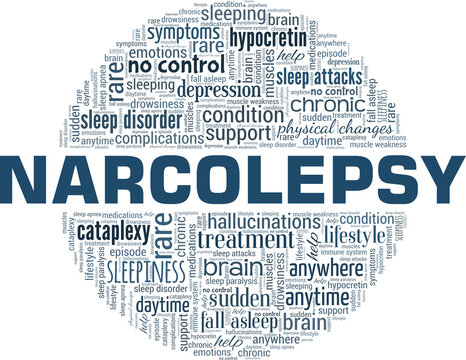Living with Narcolepsy: Coping Strategies and Lifestyle Management
Narcolepsy, a sleep disorder affecting many, disrupts daily life with its uncontrollable sleep episodes. People with narcolepsy encounter challenges such as sudden drowsiness and loss of muscle control, impacting work, relationships, and safety. Coping is crucial. This blog sheds light on practical strategies to manage narcolepsy’s effects. From establishing regular sleep routines and incorporating scheduled naps to embracing a healthy lifestyle and stress reduction techniques, these practices can greatly improve daily life. Recognizing the significance of effective coping strategies and lifestyle adjustments is essential for enhancing the well-being and quality of life for individuals dealing with narcolepsy.

Living with Narcolepsy
Understanding narcolepsy:
Narcolepsy, an intricate sleep disorder, brings forth sudden and uncontrolled daytime sleep episodes. Its primary symptoms encompass disrupted sleep patterns, causing individuals to grapple with irregular sleep-wake cycles. Consequently, excessive daytime sleepiness takes hold, casting a shadow over focus and daily engagements. Yet, narcolepsy’s impact extends beyond the physical realm, weaving into emotions as frustration, anxiety, and even depression can surface due to its unpredictable nature. Furthermore, the disorder’s social repercussions materialize in reduced social involvement and relationship complexities. An in-depth comprehension of narcolepsy’s intricacies is vital to grasp its wide-ranging influence on physical and emotional well-being. Living with Narcolepsy
Coping strategies for narcolepsy:
Coping with narcolepsy demands a toolkit of strategies to enhance daily functioning.
- Consistent sleep routine: Firstly, establishing a consistent sleep routine is pivotal. Maintaining regular sleep and wake times aids in regulating the body’s internal clock, contributing to better sleep quality. Crafting a sleep-conducive environment, with comfortable bedding and minimal distractions, further supports restful slumber. Living with Narcolepsy
Scheduled naps form another integral technique. Brief, planned naps combat daytime sleepiness. Integrating these into your routine, perhaps during breaks, can recharge your energy without interfering with nighttime sleep.
- Healthy lifestyle habits: Healthy lifestyle habits play a substantial role. Regular exercise and a balanced diet bolster overall well-being and can aid in managing narcolepsy symptoms. Hydration and moderation in caffeine intake offer additional benefits, keeping you alert and avoiding sleep disruptions. Living with Narcolepsy
- Managing stress: Stress management enters the equation too. Practices like meditation, deep breathing, and yoga alleviate stress, potentially improving sleep quality. Since stress can exacerbate narcolepsy symptoms, cultivating these techniques contributes to better symptom control. Living with Narcolepsy
By implementing these coping strategies, individuals with narcolepsy can proactively navigate challenges, fostering a more balanced and fulfilling lifestyle. It’s important to consult with healthcare professionals to tailor these strategies to your specific needs, ensuring a comprehensive approach to managing narcolepsy’s impact. Living with Narcolepsy
Medications for narcolepsy: Modalert 100
In the realm of managing sleep disorders, Modalert 100 mg, powered by the active ingredient modafinil, emerges as a significant pharmaceutical solution, particularly for individuals grappling with narcolepsy. Manufactured by Sun Pharma, this medication stands as a beacon of hope with a shelf life of 2 years, ensuring both efficacy and reliability. Living with Narcolepsy
Renowned for its remarkable ability to promote wakefulness and enhance cognitive function, Modalert 100 mg has become a lifeline for those navigating the challenges of narcolepsy and related sleep disorders. Its mechanism of action involves the stimulation of crucial neurotransmitters in the brain, including dopamine and norepinephrine. By engaging these neurotransmitters, it effectively combats one of narcolepsy’s hallmark symptoms—excessive daytime sleepiness—ultimately leading to improved alertness. Living with Narcolepsy
Modalert 100 mg‘s prowess extends beyond narcolepsy’s borders. While it shines as a cornerstone of narcolepsy treatment, its benefits extend to a wider horizon of sleep-related conditions. Notably, it has demonstrated efficacy in addressing obstructive sleep apnea and shift work sleep disorder, positioning itself as a versatile option catering to a diverse range of patients.
Beyond offering relief from the challenges posed by sleep disorders, Modalert 100 mg empowers individuals to reclaim command over their daily lives. Its role in heightening alertness and overall functionality underscores its potential to revolutionize the landscape of sleep medicine. As the dawn of wakefulness breaks through the darkness of sleepiness, Modalert 100 mg stands tall as a potential game-changer in the pursuit of balanced and invigorated living. Living with Narcolepsy
Communication and support:
Open communication stands as a cornerstone in navigating the challenges of narcolepsy. Sharing the realities of the condition with family, friends, and employers fosters understanding and empathy. Transparent discussions about narcolepsy’s impact on daily life, such as sudden sleep episodes and fatigue, can help manage expectations and garner crucial support systems.
Support groups and therapy play pivotal roles in managing the emotional hurdles associated with narcolepsy. Engaging in support groups connects individuals with shared experiences, offering a platform to exchange coping strategies and emotional support. Professional therapy, including cognitive-behavioral approaches, equips individuals with tools to manage anxiety, stress, and depression, which often accompany narcolepsy. Living with Narcolepsy
Through open conversations and supportive networks, the journey of living with narcolepsy becomes more manageable. These pillars of communication and support not only aid in navigating the practical challenges but also provide the emotional scaffolding necessary for a more balanced and empowered life. Living with Narcolepsy
Overcoming challenges:
Within the tapestry of narcolepsy, stories of resilience shine brightly. Individuals have conquered the odds, demonstrating that effective management is attainable. These narratives of triumph—where careers were nurtured, relationships flourished, and dreams realized—inspire hope. Living with Narcolepsy
To those on the journey, remember that success stories are not isolated instances but attainable milestones. With diligence, support, and the right strategies, narcolepsy’s hurdles can be navigated. Embrace the possibilities, armed with the knowledge that overcoming challenges is within reach. The path to empowerment is illuminated by those who’ve paved the way, reminding us that a fulfilling life, despite narcolepsy’s presence, is both achievable and worth pursuing.
Conclusion:
As we conclude this journey through narcolepsy’s challenges and coping strategies, remember this: empowerment prevails. By weaving together sleep routines, strategic naps, healthy habits, and stress management, individuals can reclaim their lives. Medications like Modalert 100 mg provide renewed vitality. Supportive communication and shared experiences amplify resilience, paving the way for emotional well-being. Inspirational stories underline the achievable triumphs. Narcolepsy’s hurdles are navigable. This journey is a testament to human strength. With determination and community, life with narcolepsy becomes an adventure of empowerment, proving that living fully is not just a dream but an attainable reality. Living with Narcolepsy
